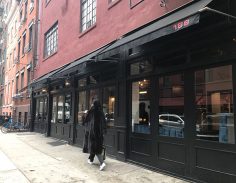By Caroline Benveniste

All too often, we report sad real estate stories—buildings being torn down and replaced with condos or offices, local shops closing because of steep rent increases, and other changes that make the Village less unique. Finally, we have a story that starts like all the others but ends happily.
The Church of St. Veronica, located at 149 Christopher Street, struggled like many churches with the expense of maintaining its building, a dwindling congregation, and a shortage of priests. The situation was so dire that the Catholic Church was poised to sell the building to a developer for condos. But, luckily for the West Village, Jorge Navarro was there to provide a workable alternative.
Jorge is a Flamenco dancer by training. He started dance lessons with his grandmother in Andalucía, Spain when he was 12 years old. By the time he was 17, he had joined a dance company and was touring Europe and America. While performing in New York, Jorge fell in love with the city, and since this was the 1970s, he was able to get a job, was sponsored for a green card, and eventually became a naturalized citizen. By the 1980s, he had founded his own dance company. He also married a Korean fashion designer and had a daughter (who now teaches music therapy). In 1999, Jorge was featured in a New York Times article about the renewed interest in Flamenco, where the author reported on a Flamenco class she took with him.
In 2003, Jorge founded Arts Flamenco, an organization whose mission includes working with guest artists, educational outreach and, according to the website, preserving “the traditions of flamenco, while also evolving it as an art form for now and the future.” He and his partner, Antonio Hidalgo, taught classes and held Flamenco shows on Saturday evenings.
While Arts Flamenco was and is very successful, finding affordable studio space was becoming increasingly difficult. Studio space is plentiful in Midtown West, but the prices are extremely high. This situation led Jorge to an idea: He would find a space where he could build studios and give lessons, and also rent out the studios to others who wished to have performing arts classes. Jorge had spoken to a priest at a church on the West Side about his plans, and that priest said he might have a space that could work. Thus, Jorge saw the basement of St. Veronica and knew at once that it was the right spot. Not only did the space speak to him, but because it was subterranean, there would be no noise issues with neighbors. Jorge also liked the idea of being in the West Village. One of the first places he performed at in NYC was Alegrías (his ‘tablao restaurant’), a tapas bar at 46 Bedford Street.
The first negotiations with the Catholic Church involved representatives from St. Patrick’s. After more discussions, Father Santiago Rubio ultimately agreed to the plan. Following some renovations, in October 2015 (one year and eight months after Jorge first viewed the space), the Creative Cultural Center opened.
The Center has six studios of varying sizes, which are suitable for different purposes. There is also a stage connected to the main studio which can be used for performances. As Jorge had hoped, there is a strong demand for the space. The studios are used for voice lessons, children’s afternoon and weekend dance classes, ballet, African dance, tap, yoga, and more. It has become, as he had hoped, a de facto community space.


